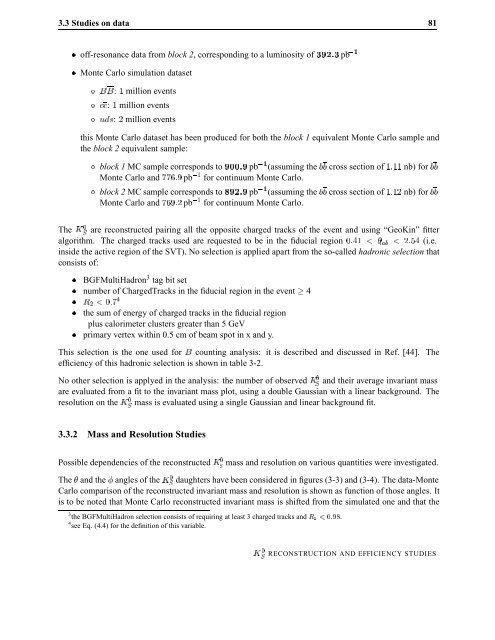Violation in Mixing
Violation in Mixing
Violation in Mixing
Create successful ePaper yourself
Turn your PDF publications into a flip-book with our unique Google optimized e-Paper software.
3.3 Studies on data 81<br />
¯ off-resonance data from block 2, correspond<strong>in</strong>g to a lum<strong>in</strong>osity of � � pb<br />
¯ Monte Carlo simulation dataset<br />
Æ ��: million events<br />
Æ : million events<br />
Æ Ù�×: million events<br />
this Monte Carlo dataset has been produced for both the block 1 equivalent Monte Carlo sample and<br />
the block 2 equivalent sample:<br />
Æ block 1 MC sample corresponds to � �� pb (assum<strong>in</strong>g the �� cross section of � nb) for ��<br />
Monte Carlo and ����� pb for cont<strong>in</strong>uum Monte Carlo.<br />
Æ block 2 MC sample corresponds to �� �� pb (assum<strong>in</strong>g the �� cross section of � nb) for ��<br />
Monte Carlo and ���� pb for cont<strong>in</strong>uum Monte Carlo.<br />
The Ã Ë are reconstructed pair<strong>in</strong>g all the opposite charged tracks of the event and us<strong>in</strong>g “GeoK<strong>in</strong>” fitter<br />
algorithm. The charged tracks used are requested to be <strong>in</strong> the fiducial region �� � ��� � ��� (i.e.<br />
<strong>in</strong>side the active region of the SVT). No selection is applied apart from the so-called hadronic selection that<br />
consists of:<br />
¯ BGFMultiHadron 3 tag bit set<br />
¯ number of ChargedTracks <strong>in</strong> the fiducial region <strong>in</strong> the event � 4<br />
¯ Ê � �� 4<br />
¯ the sum of energy of charged tracks <strong>in</strong> the fiducial region<br />
plus calorimeter clusters greater than 5 GeV<br />
¯ primary vertex with<strong>in</strong> 0.5 cm of beam spot <strong>in</strong> x and y.<br />
This selection is the one used for � count<strong>in</strong>g analysis: it is described and discussed <strong>in</strong> Ref. [44]. The<br />
efficiency of this hadronic selection is shown <strong>in</strong> table 3-2.<br />
No other selection is applyed <strong>in</strong> the analysis: the number of observed Ã Ë and their average <strong>in</strong>variant mass<br />
are evaluated from a fit to the <strong>in</strong>variant mass plot, us<strong>in</strong>g a double Gaussian with a l<strong>in</strong>ear background. The<br />
resolution on the Ã Ë mass is evaluated us<strong>in</strong>g a s<strong>in</strong>gle Gaussian and l<strong>in</strong>ear background fit.<br />
3.3.2 Mass and Resolution Studies<br />
Possible dependencies of the reconstructed Ã Ë mass and resolution on various quantities were <strong>in</strong>vestigated.<br />
The � and the � angles of the Ã Ë daughters have been considered <strong>in</strong> figures (3-3) and (3-4). The data-Monte<br />
Carlo comparison of the reconstructed <strong>in</strong>variant mass and resolution is shown as function of those angles. It<br />
is to be noted that Monte Carlo reconstructed <strong>in</strong>variant mass is shifted from the simulated one and that the<br />
3 the BGFMultiHadron selection consists of requir<strong>in</strong>g at least 3 charged tracks and Ê � ���.<br />
4 see Eq. (4.4) for the def<strong>in</strong>ition of this variable.<br />
Ã Ë RECONSTRUCTION AND EFFICIENCY STUDIES















